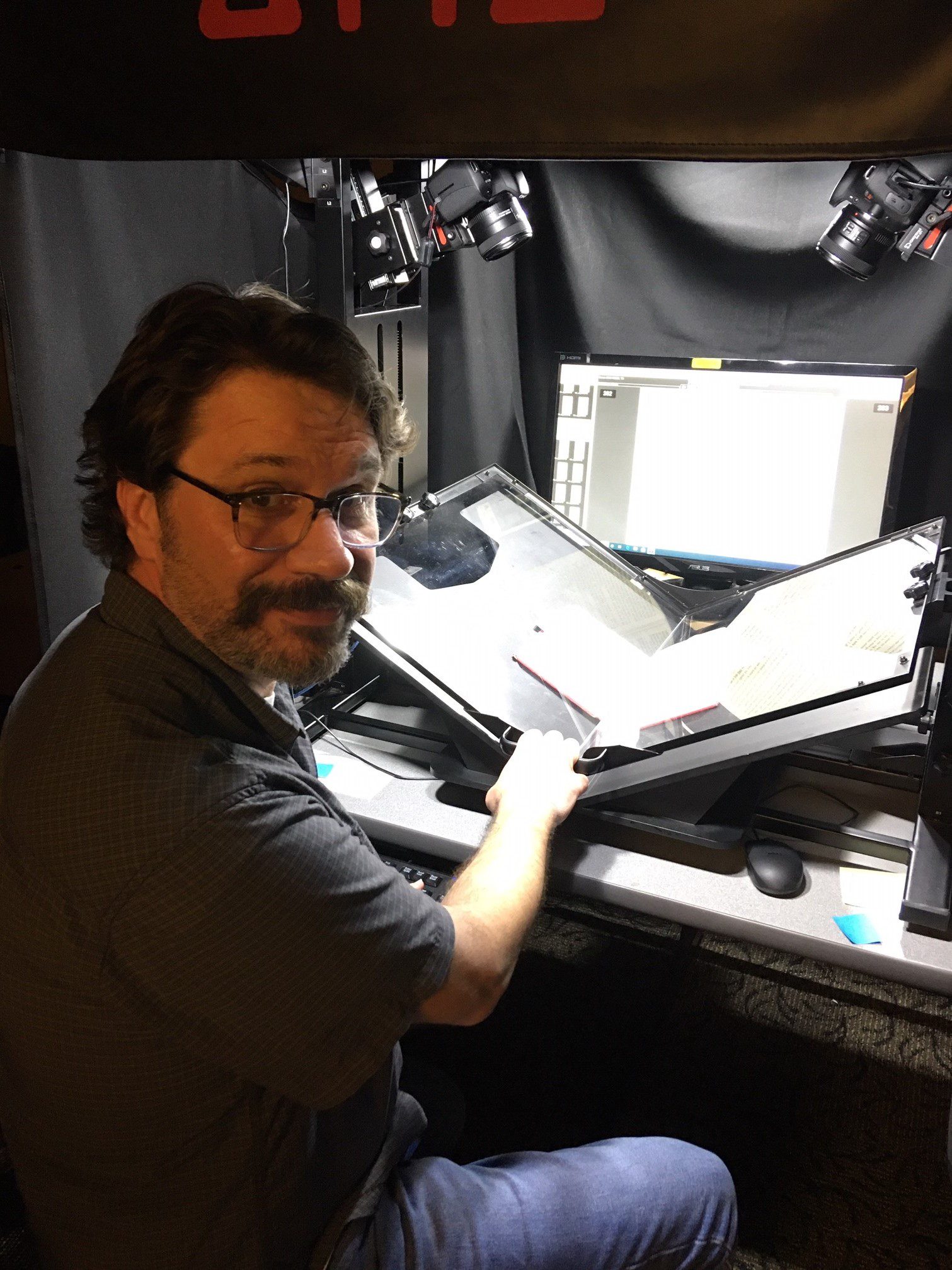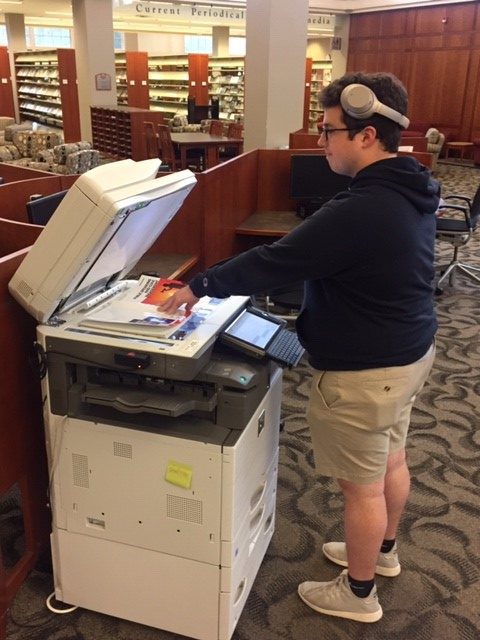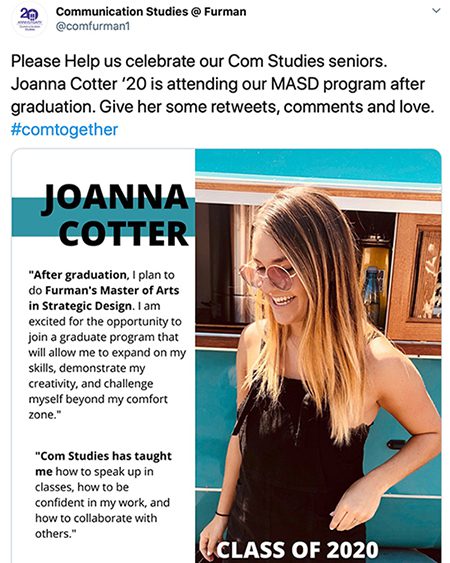With digital tools and creativity, Furman meets the challenges of remote learning

While the COVID-19 pandemic – and the ensuing shift to remote learning – has scattered students far from campus, Furman faculty and staff are taking powerful measures to help them to adapt and thrive.
From helping faculty members find remote ways to continue their personal interactions with their students to finding creative ways to help students feel together while they are apart, the Furman community has stepped up.
“One of the great things I’ve seen come out of this is how everyone is coming together and doing what’s best for students,” said Judy Bagley, director of Furman’s Student Office for Accessibility Resources (SOAR). “It’s every department, every unit.”
SOAR’s mission is to create an accessible, inclusive and sustainable learning environment for students with disabilities. By assisting departments across campus, SOAR works with individual students to provide the accommodations they need to be successful.
“That hasn’t changed. That’s what we’re still doing,” Bagley said. “But the way we do it and the accommodations students need is different now.”
Zoom, Box and Moodle, to name a few
To accommodate students who need extended time on tests, SOAR is working with faculty to increase the time allowed on Moodle, Furman’s learning management system. In other cases, SOAR is proctoring exams through Zoom, she said.
But sometimes, accommodations used in a regular classroom setting don’t work remotely. For instance, some hearing-impaired students use FM devices in class. Their professor wears a microphone that feeds directly into their cochlear implant. But the system doesn’t work well over the computer. In those cases, SOAR is setting up live captioning so that students have equal access to the lecture.
Some students who do well in a “paper-and-pencil” setting struggle to read text and take tests on the computer, Bagley said. In those cases, SOAR is working with P2X (Print & Post Express) to print and ship materials to students.
“Mr. Rogers said when in crisis, look for the helpers, and I have definitely seen all the helpers,” Bagley said. “Furman has stepped up, and it makes me proud to work here.”
During the extended spring break, Furman Libraries helped faculty access the resources they needed to move classes online. The libraries were open so faculty could attend training, workshops and get technical support, said Jenny Colvin, assistant director for outreach for Furman University Libraries.
“Everybody in the library had a role to play because we all worked together to support students,” she said.

Micah Arms ’21, a student assistant, scans class materials at James B. Duke Library.
Colvin said that because Furman is a heavily residential campus, most students accessed library services in person before the campus closed. However, the library has always responded to requests for help in a virtual environment through online chat, text or email, she said.
Research assistance is available virtually until 10 p.m. most nights. Students and faculty may make appointments with librarians for research consultations conducted over the phone, Zoom or Skype, she said. If a student needs material that is not available digitally, library staff are scanning chapters or pages of books and sending it to students, Colvin said.
“It’s a popular time of year for research papers,” she added.
Also, Furman’s outreach librarians are meeting with classes live through Zoom, recording lectures that students can access through Box or Moodle, and creating online tutorials to fill in gaps.
“A lot of times, it feels like the work that the library does is a little invisible because we provide all this access to information that people can get to on their own,” she said. “I think this reinforces how much work the library does to support the academic life of the university.”
Rapid progress
Susan Dunnavant, director of learning technologies for Furman’s Information Technology Services, said faculty members value personal interaction with students every bit as much as the students do.
“Interacting remotely is not the same as the personal attention so highly prized at Furman, and the adjustments require not only appropriate technology, but innovative and resourceful use of it,” she said. “Our role of technicians includes encouragement for our user community.”
ITS has provided loaner technology for students who did not have hardware or devices to take part in their required activities and classes. The office also increased access to proprietary software systems ordinarily available only from on-campus systems. It increased the number of Furman professional Zoom accounts. It conducted practice sessions for faculty and students, helped faculty create videos and high-quality audio lectures, and provided training for expanded use of Moodle.
Dunnavant said the initial concerns were logistical and mechanical – how to set up a meeting in Zoom, how to join a meeting, how to share material and whether a user’s camera worked. But now, the requests have become more sophisticated, she said. Faculty members are asking how their students can work together on projects and then practice before presenting something to the whole class.
“On the other end of this, I think some faculty members may end up using some of these tools in a limited fashion as an enhancement to the things they’re doing in the classroom,” she said. “Some may have had an interest in doing some blended learning, but they hadn’t had the time. Now, they have the time to learn how to do it because there isn’t any choice.”
A perfect time to #comtogether
ITS and others aren’t the only ones that are finding creative ways to serve students during a time when connection may be more important than ever.

A recent tweet using the hashtag #comtogether.
“For communication studies students, the hashtag #comtogether is a way to promote togetherness during the pandemic and serve as a learning experience in social media strategy,” said Mary Sturgill, a media specialist and instructor in the Department of Communication Studies.
The hashtag came about through brainstorming between communication studies students and some professors. In addition to sharing departmental information, the main part of the campaign includes highlighting senior communication studies majors.
“They’ve lost so much during this pandemic,” Sturgill said. “They’ve lost the last couple of months of their college life that they won’t ever get back, so we are trying to do something to honor them.”
Each week, the department’s social media platforms feature new students. The department encourages students, family and professors to post encouragement and memories for each senior.
“It’s a way to make our students feel connected in a world that feels so unconnected,” Sturgill said. “Even though we’re separated, we’re all in this together. We’re supporting and uplifting each other.”